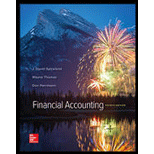
FINANCIAL ACCOUNTINGLL W/CONNECT >IC<
4th Edition
ISBN: 9781259934773
Author: SPICELAND
Publisher: MCG
expand_more
expand_more
format_list_bulleted
Textbook Question
Chapter 12, Problem 12.14BE
Classify each of the following accounting practices as conservative or aggressive.
1. Increase the allowance for uncollectible accounts.
2. When costs are rising, change from LIFO to FIFO.
3. Change from declining-balance to straight-line
Expert Solution & Answer
Want to see the full answer?
Check out a sample textbook solution
Students have asked these similar questions
Can you help me solve this financial accounting question using the correct financial procedures?
Accounting?
I need help with this general accounting problem using proper accounting guidelines.
Chapter 12 Solutions
FINANCIAL ACCOUNTINGLL W/CONNECT >IC<
Ch. 12 - Prob. 1RQCh. 12 - Prob. 2RQCh. 12 - Prob. 3RQCh. 12 - Prob. 4RQCh. 12 - 5.In performing horizontal analysis, why is it...Ch. 12 - Prob. 6RQCh. 12 - Prob. 7RQCh. 12 - Prob. 8RQCh. 12 - Prob. 9RQCh. 12 - Prob. 10RQ
Ch. 12 - Prob. 11RQCh. 12 - Prob. 12RQCh. 12 - Prob. 13RQCh. 12 - Prob. 14RQCh. 12 - Prob. 15RQCh. 12 - Prob. 16RQCh. 12 - Prob. 17RQCh. 12 - Prob. 18RQCh. 12 - Prob. 19RQCh. 12 - Prob. 20RQCh. 12 - Prob. 12.1BECh. 12 - Prob. 12.2BECh. 12 - Prob. 12.3BECh. 12 - Prob. 12.4BECh. 12 - Prob. 12.5BECh. 12 - Universal Sports Supply began the year with an...Ch. 12 - Prob. 12.7BECh. 12 - Prob. 12.8BECh. 12 - Prob. 12.9BECh. 12 - Prob. 12.10BECh. 12 - Prob. 12.11BECh. 12 - Prob. 12.12BECh. 12 - Prob. 12.13BECh. 12 - Classify each of the following accounting...Ch. 12 - Classify each of the following accepted accounting...Ch. 12 - Prob. 12.1ECh. 12 - Prob. 12.2ECh. 12 - Prob. 12.3ECh. 12 - Prob. 12.4ECh. 12 - Prob. 12.5ECh. 12 - Refer to the information for Adrian Express in...Ch. 12 - Prob. 12.7ECh. 12 - Calculate profitability ratios (LO124) Refer to...Ch. 12 - Prob. 12.9ECh. 12 - The income statement for Stretch-Tape Corporation...Ch. 12 - Prob. 12.11ECh. 12 - LeBrons Bookstores has two divisions, books and...Ch. 12 - Prob. 12.13ECh. 12 - Prob. 12.14ECh. 12 - Distinguish between conservative and aggressive...Ch. 12 - Prob. 12.1APCh. 12 - Prob. 12.2APCh. 12 - Prob. 12.3APCh. 12 - Prob. 12.4APCh. 12 - Prob. 12.5APCh. 12 - Prob. 12.6APCh. 12 - Game-On Sports operates in two distinct segments:...Ch. 12 - Prob. 12.2BPCh. 12 - Prob. 12.3BPCh. 12 - Prob. 12.4BPCh. 12 - Prob. 12.5BPCh. 12 - Prob. 12.6BPCh. 12 - Prob. 12.1APCPCh. 12 - Prob. 12.2APFACh. 12 - Prob. 12.3APFACh. 12 - Prob. 12.4APCACh. 12 - Prob. 12.5APECh. 12 - Prob. 12.7APWCCh. 12 - Prob. 12.8APEM
Knowledge Booster
Learn more about
Need a deep-dive on the concept behind this application? Look no further. Learn more about this topic, accounting and related others by exploring similar questions and additional content below.Similar questions
- Question 1181 28 Current Attempt in Progress Here are comparative balance sheets for Migitsu Company. Prepare a statement of cash flows-indirect method. MIGITSU COMPANY Comparative Balance Sheets December 31 Assets 2020 2019 Cash $73,000 $22,000 Accounts receivable 87,000 76.000 Inventory 170,000 191.000 Land 72,000 100.000 Equipment 260,000 200.000 Accumulated depreciation - equipment (66,000) (32.000) Total $596,000 $557,000 Liabilities and Stockholders' Equity Accounts payable $37,000 $47.000 Bonds payable 150,000 210,000 Common stock ($1 par) 216.000 174,000 Retained earnings 193,000 126.000 Total $596,000 $557,000 Additional information: 1 Net income for 2020 was $100,000. N Cash dividends of $33,000 were declared and paid. 3. Bonds payable amounting to $60,000 were redeemed for cash $60,000. -18 4. Common stock was issued for $42,000 cash. 5. Equipment that cost $50,000 and had a book value of $30,000 was sold for $36,000 during 2020; land was sold at cost.arrow_forwardI need guidance with this general accounting problem using the right accounting principles.arrow_forwardI need assistance with this general accounting question using appropriate principles.arrow_forward
arrow_back_ios
SEE MORE QUESTIONS
arrow_forward_ios
Recommended textbooks for you
 College Accounting, Chapters 1-27AccountingISBN:9781337794756Author:HEINTZ, James A.Publisher:Cengage Learning,
College Accounting, Chapters 1-27AccountingISBN:9781337794756Author:HEINTZ, James A.Publisher:Cengage Learning, Auditing: A Risk Based-Approach to Conducting a Q...AccountingISBN:9781305080577Author:Karla M Johnstone, Audrey A. Gramling, Larry E. RittenbergPublisher:South-Western College Pub
Auditing: A Risk Based-Approach to Conducting a Q...AccountingISBN:9781305080577Author:Karla M Johnstone, Audrey A. Gramling, Larry E. RittenbergPublisher:South-Western College Pub Auditing: A Risk Based-Approach (MindTap Course L...AccountingISBN:9781337619455Author:Karla M Johnstone, Audrey A. Gramling, Larry E. RittenbergPublisher:Cengage Learning
Auditing: A Risk Based-Approach (MindTap Course L...AccountingISBN:9781337619455Author:Karla M Johnstone, Audrey A. Gramling, Larry E. RittenbergPublisher:Cengage Learning- Principles of Accounting Volume 1AccountingISBN:9781947172685Author:OpenStaxPublisher:OpenStax College

College Accounting, Chapters 1-27
Accounting
ISBN:9781337794756
Author:HEINTZ, James A.
Publisher:Cengage Learning,

Auditing: A Risk Based-Approach to Conducting a Q...
Accounting
ISBN:9781305080577
Author:Karla M Johnstone, Audrey A. Gramling, Larry E. Rittenberg
Publisher:South-Western College Pub

Auditing: A Risk Based-Approach (MindTap Course L...
Accounting
ISBN:9781337619455
Author:Karla M Johnstone, Audrey A. Gramling, Larry E. Rittenberg
Publisher:Cengage Learning

Principles of Accounting Volume 1
Accounting
ISBN:9781947172685
Author:OpenStax
Publisher:OpenStax College

Accounting Changes and Error Analysis: Intermediate Accounting Chapter 22; Author: Finally Learn;https://www.youtube.com/watch?v=c2uQdN53MV4;License: Standard Youtube License